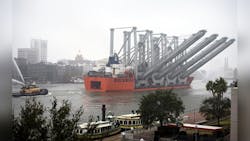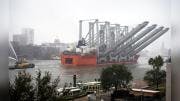Port of Savannah raises Panamax crane total to 26
Four new Super Post Panamax ship-to-shore cranes arrived at Garden City Terminal recently, bringing the Port of Savannah GA’s total to 26, more than any other terminal in the United States.
“For customers, it means the capacity to move up to a thousand containers per hour across a single dock at America’s largest terminal—allowing us to work more vessels, more quickly,” said Georgia Ports Authority Executive Director Griff Lynch. “It means getting cargo to market and getting ships back out to sea with unmatched efficiency.”
Designed by Konecranes of Finland, these enormous cranes can work the largest ships calling on the US East Coast, reaching across vessels 22 containers wide.
“We’re growing our crane fleet in order to stay ahead of demand,” said Ed McCarthy, GPA chief operating officer. “Since the opening of the expanded Panama Canal in June, Garden City Terminal has seen a 40% increase in the number of vessels carrying 8,000 or more twenty-foot equivalent container units. Over the same period, the Port of Savannah has seen a 21% increase in the number of TEUs handled per vessel.”
Counting the new cranes, Savannah now features 20 New Panamax cranes and six post-panamax cranes (reaching 17 containers across). Another four New Panamax cranes are due to arrive in 2018, bringing Savannah’s total to 30. The cranes operate over a dock with nearly 10,000 feet of contiguous berth space.
Along with the Savannah Harbor deepening, the new cranes help accommodate a move in the world fleet toward larger ships. Through its expanded locks, the Panama Canal can now accommodate vessels with a capacity of 14,000 TEUs—nearly triple the size of the canal’s previous maximum. This opens an important new route for the more efficient ships to serve the US East Coast.
On the Journal of Commerce website, Greg Knowler, senior Asia editor, discusses the industry plight of idle container ships due to overcapacity and a lack of demand. This article outlines his concerns:
The number of idle ships has increased from 238 vessels in November 2015, with a combined capacity of about 900,000 twenty-foot-equivalent units, to 435 ships aggregating 1.7 million TEUs in early November of this year, according to industry analyst Drewry.
At the beginning of 2015, idle container ships comprised just 2.5% of the global fleet, and ships laid up in quiet waterways around the world now account for 9% of the global fleet.
The growth of the idle fleet may have been rapid, but of the 1.7 million idle TEUs, Hanjin Shipping generated 36% of that capacity during the last quarter when it collapsed. Drewry said the former Hanjin-operated fleet accounted for 622,958 TEUs, and of this, about 200,000 TEUs was for ships of more than 10,000 TEUs.
As for the Port of Savannah, officials said improvements to the port’s crane fleet demonstrate the GPA’s commitment to expand capacity, providing more opportunities for growth and greater flexibility to meet customer needs.
“Garden City Terminal completes 100,000 container transactions every week,” said Jimmy Allgood, GPA board chairman. “Keeping all those transactions moving smoothly requires the authority to maintain capacity at least 20% above demand. Our new cranes help to ensure the terminal remains congestion-free and efficient for customers.”
For more information, see www.gaports.com.

